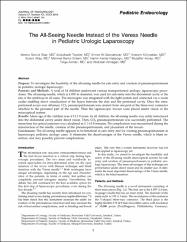| dc.contributor.author | Mesrur, Silay Selçuk | |
| dc.contributor.author | Tepeler, Abdulkadir | |
| dc.contributor.author | Sancaktutar, Ahmet Ali | |
| dc.contributor.author | Kılınçaslan, Hüseyin | |
| dc.contributor.author | Altay, Bülent | |
| dc.contributor.author | Erdem, Mehmet Remzi | |
| dc.contributor.author | Hatipoğlu, Namık Kemal | |
| dc.contributor.author | Akçay, Muzaffer | |
| dc.contributor.author | Akman, Tolga | |
| dc.contributor.author | Armağan, Abdullah | |
| dc.date.accessioned | 10.07.201910:49:13 | |
| dc.date.accessioned | 2019-07-10T19:58:04Z | |
| dc.date.available | 10.07.201910:49:13 | |
| dc.date.available | 2019-07-10T19:58:04Z | |
| dc.date.issued | 2013 | en_US |
| dc.identifier.citation | Mesrur, S. S., Tepeler, A., Sancaktutar, A. A., Kılınçaslan, H., Altay, B., Erdem, Mehmet R. ... Armağan, A. (2013). The all-seeing needle instead of the veress needle in pediatric urologic laparoscopy. Journal Of Endourology, 27(11), 1376-1380. https://dx.doi.org/10.1089/end.2013.0054 | en_US |
| dc.identifier.issn | 0892-7790 | |
| dc.identifier.issn | 1557-900X | |
| dc.identifier.uri | https://dx.doi.org/10.1089/end.2013.0054 | |
| dc.identifier.uri | https://hdl.handle.net/20.500.12511/3101 | |
| dc.description | WOS: 000326970200011 | en_US |
| dc.description | PubMed ID: 23560687 | en_US |
| dc.description.abstract | Purpose: To investigate the feasibility of the all-seeing needle for safe entry and creation of pneumoperitoneum in pediatric urologic laparoscopy. Patients and Methods: A total of 14 children underwent various transperitoneal urologic laparoscopic procedures. The all-seeing needle, which is 4.85F in diameter, was used for safe entry into the abdominal cavity at the site of the umblicus in all cases. The microoptic was integrated with the light system and connected via a zoom ocular enabling direct visualization of the layers between the skin and the peritoneal cavity. Once the intraperitoneal access was obtained, CO2 pneumoperitoneum was created from one port of the three-way connector attached to the proximal part of the needle. Then the laparoscopic trocars were placed under vision of the microoptical system. Results: Mean age of the children was 4.52.9 years. In all children, the all-seeing needle was safely introduced into the abdominal cavity under direct vision. Then, CO2 pneumoperitoneum was succesfully performed. The mean time for optical puncture was calculated as 1.1 +/- 0.8 minutes. No complication was encountered during the introduction of the needle, creation of the pneumoperitoneum, and placement of the trocars. Conclusions: The all-seeing needle appears to be beneficial in safe entry and for creating pneumoperitoneum in laparoscopic pediatric urology cases. It eliminates the disadvantages of the Veress needle, which is blunt insertion, and may possibly prevent complications. | en_US |
| dc.language.iso | eng | en_US |
| dc.publisher | Mary Ann Liebert, Inc | en_US |
| dc.rights | info:eu-repo/semantics/openAccess | en_US |
| dc.subject | All-Seeing | en_US |
| dc.subject | Needle Instead | en_US |
| dc.subject | Veress Needle | en_US |
| dc.subject | Pediatric Urologic | en_US |
| dc.subject | Laparoscopy | en_US |
| dc.title | The all-seeing needle instead of the veress needle in pediatric urologic laparoscopy | en_US |
| dc.type | article | en_US |
| dc.relation.ispartof | Journal Of Endourology | en_US |
| dc.department | İstanbul Medipol Üniversitesi, Tıp Fakültesi, Cerrahi Tıp Bilimleri Bölümü, Üroloji Ana Bilim Dalı | en_US |
| dc.identifier.volume | 27 | en_US |
| dc.identifier.issue | 11 | en_US |
| dc.identifier.startpage | 1376 | en_US |
| dc.identifier.endpage | 1380 | en_US |
| dc.relation.publicationcategory | Makale - Uluslararası Hakemli Dergi - Kurum Öğretim Elemanı | en_US |
| dc.identifier.doi | 10.1089/end.2013.0054 | en_US |
| dc.identifier.wosquality | Q2 | en_US |
| dc.identifier.scopusquality | Q1 | en_US |


















